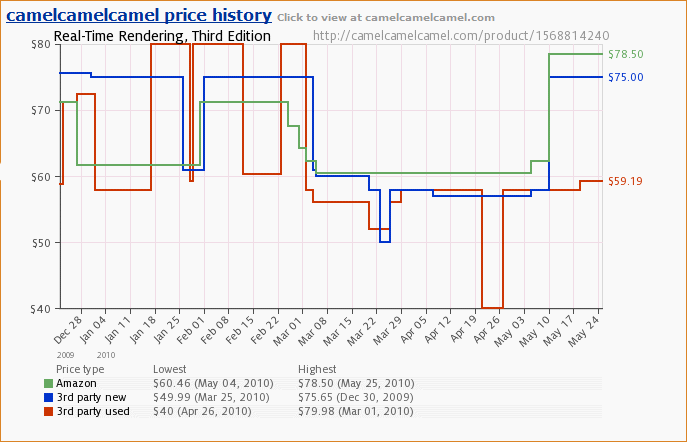It’s 5/7/09, a nice odd sequence, so time for a few odds and ends I’ve collected.
OK, this is worth a few minutes of your life: the elevated demo is awe-inspiring. Terrain generation (be patient when you start it), fly-by’s, and music, all in less than 4096 bytes. By way of comparison, an empty MS Word document is 9834 bytes. (thanks to Steve Worley)
Google has put out a browser-based low-level 3D graphics API called O3D. API here. Demos here. Some initial impressions here. It will be interesting to see if they succeed where so many others have failed.
There is a call for participation out for a new book series called “Game Engine Gems“, edited by Eric Lengyel. (thanks to Marwan Ansari)
The main thing I look at on the SIGGRAPH exhibition floor are the book booths. Good books are such a ridiculous bargain: if a book like Geometric Tools saves a programmer 2 hours of time, it’s paid for itself. One new book that I want to see is Real-Time Cameras, by Mark Haigh-Hutchinson, which came out this April. Looking around for more info, I noticed this sad note. I never met Mark, but we corresponded a few times. He came up with a clever idea to avoid performing division when doing a point in polygon test; I folded this into the CrossingsMultiplyTest Graphics Gems code here, crediting him.
I’ve been looking at GPU capabilities and benchmarking information lately. Some nice resources:
- You probably know about the benchmarking group Futuremark. Me, I hadn’t realized they had useful stats at their site: see the Futuremark ORB links at the bottom of the page and start clicking.
- Two applications that tell you a ton about your card’s capabilities: GPU-Z, with a ton of information and a statistics page & cute map of downloads at their site, and GPU Caps, which also includes CUDA-related information and some nice little OpenGL benchmarks.
- Chris Dragan has a web database that provides a fair amount of data on card support for DirectX capabilities and OpenGL extensions.
- The Notebook Check site had way too much information about many laptop graphics accelerators.
- nHancer is a utility for NVIDIA cards. It lets you get at all sorts of different capabilities on your GPU, on a per-game basis. There are also interesting antialiasing and anisotropic filtering comparison pages (click on the radio buttons). (thanks to Mauricio Vives)
Some interesting libraries I ran across lately:
- GTS is an open-source mesh manipulation package.
- Box2D is a 2D physics engine.
- Touchlib is a multitouch development kit. (thanks to Morgan McGuire)
Coincidental world: it turns out there’s a different “Eric Haines” out there that made a well-received 3D graphics game for the iPhone, Realmaze 3D. I’m not sure how it compares to his The Magical Flying Pink Pony Game, which looks awesome. (thanks to Nikolai Sander)
I’ve seen similar real-world illusions, but still thought this one was pretty great. (Addendum: Morgan McGuire found this even-better video of the effect.)
